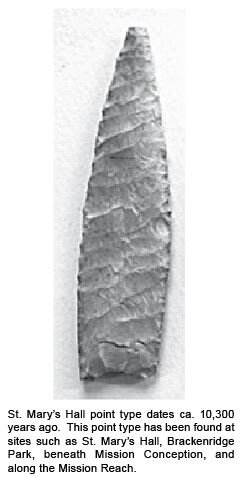INDIGENOUS HISTORY
Early Indigenous Cultures
The San Antonio River valley was the home of Native American populations long before the Spanish mission settlement, before the Spanish acequia and mission fields (labores de los Indios), and before the German and Hispanic settlement of King William neighborhood. These indigenous people first established campsites in the valley about 11,500 years ago; the richness of the region with its springs and diverse plant and animal communities attracted people through the ages. The natives never practiced agriculture until the Spanish arrived, never had horses until the Spanish introduced them, and only hunted bison at certain times in prehistory when great bison herds migrated up and down from the Great Plains.
Their material legacy is hardly recognizable; clusters of fire-cracked rock, flint chips, snail shells, bone scraps, mussel shells that are out of place, and broken artifacts are the telltale signs that archaeologists recognize. It is through the analysis and reading of this meager record that the human prehistory of the region is known.
Campsites of these ancient groups occur all along the San Antonio River. If you live on the high bank of the river chances are that evidence of these ancient campsites exist beneath your house and yard. Known locations or diagnostic artifacts have been observed at Brackenridge Park, Allison Park, Brackenridge Golf Course, on 9th Street, along Washington street, Roosevelt Park, and numerous places along the Mission Reach.
We do not know which named nations were present throughout prehistory, but only of those that were recorded by the Spanish in mission records beginning in 1718. The late Dr. Thomas N. Campbell in his article “Indians of the San Antonio Missions” (UTSA-Center for Archaeological Research Special Report 16) compiled a partial list of 68 named groups, mostly refugee groups that entered the missions at one time or another (but that is another story). No one was present 3,000 years ago or 6,000 years ago to record the names of the local natives, so we do not know to what linguistic or social group they belonged. Most of the groups attracted to the missions were non-local, and some came from as far south as Mexico, so the mission records are of little help in identifying the local indigenous groups. Among the possible local groups Campbell lists were Payaya, Mesquite, Sulujam, and Pampopa, groups we know very little about. Some historians identify those that were here at the time of Spanish contact as “Coahuiltecan,” which is a misnomer because Coahuiltecan is a linguistic group (like Endo-European) and not a social or political group. People often think of Apaches or Comanches as being among resident native groups, but they were late arrivals to the region after the Spanish.
This much we do know about the hunter-gatherers: theirs was a hard life. They moved solely by foot, carried their burdens and worldly possessions on their backs, wore little clothing made of deerskins, rabbit fur, or plant fibers, and died young (by modern standards). They always camped near water, hunted deer, opossums, squirrels or any other critter they happened to encounter, fished, and trapped small game, gathered land snails and river mussels. Their hunting, foraging and trapping territories extended across the landscape as indicated by the scatter of broken or abandoned stone tools. Their huts, if they had any at all, were pole and brush shelters that may have been insulated with clay in the winter. They lived in small family-size groups that coalesced into larger gatherings in the fall when food such as prickly pear, persimmon, mesquite, and pecans was most plentiful.
The main weapon prior to the introduction of the bow and arrow was the spear thrower (atlatl) and spear. These spears were tipped with stone points often mislabeled “arrowheads.” The bow and arrow was introduced about A.D. 800, late in prehistory in Texas. True arrow points (or “bird points” as they are often mislabeled) are small and delicately made. Point size is not an indicator of the prey as small arrow points have been found lodged in bison, deer and humans. Point styles changed through time, and archaeologist are able to establish date ranges for many of these types by radiocarbon dating the organic materials such as charcoal or bone found in association. Stone points cannot be dated directly by the radiocarbon method that requires the material to be of organic origin. Since date ranges for certain point styles are known, projectile points are used as index fossils in estimating the ages of sites or layers in which they are found. It is in this manner that we know the antiquity of archaeological sites and prehistory along the San Antonio River and its tributaries.
- Harry J. Shafer, PhD



